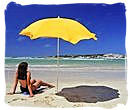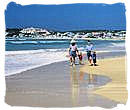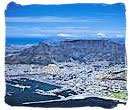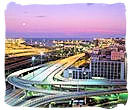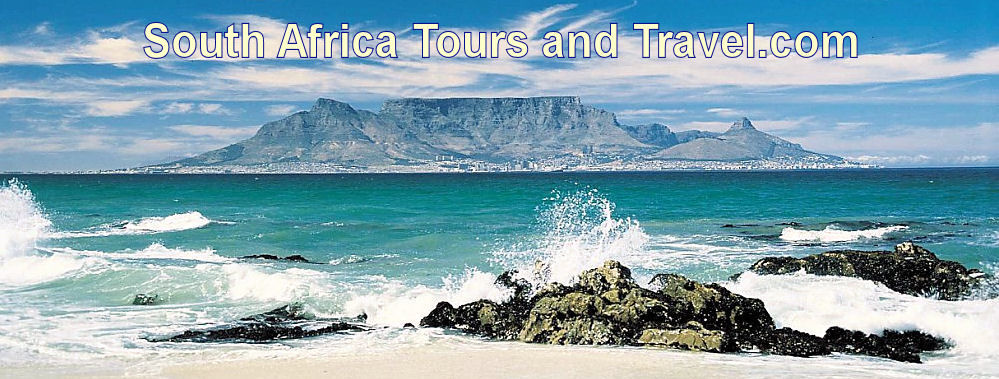 |
||||||||||||||
Bontebok National Park, |
||||||||||||||
| GENERAL INFO | |
| CLIMATE | |
| MAP | |
| ACCOMMODATION AVAILABILITY | |
| ACCOMMODATION | |
| TARIFFS | |
| FACILITIES | |
| RESERVATIONS | |
| ACTIVITIES | |
| HOW TO GET THERE | |
| VIDEO |
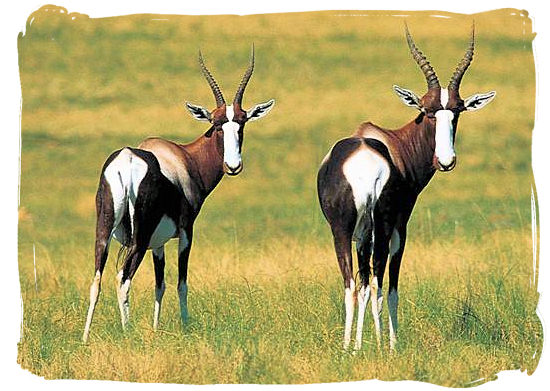
Here they are, the rarest antelope species in the world
copyright © South African tourism
General info,...
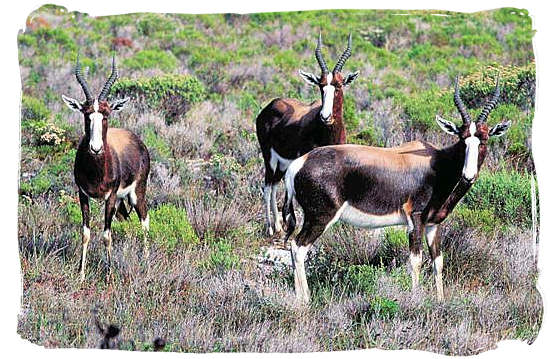
Three Bonteboks in their typical “fynbos” habitat
copyright © South African tourism
Here they flourished and by 1969 it was estimated that the herd had grown to around 800 animals, an incredible conservation success. These numbers meant that some of these antelopes could be relocated to other reserves and protected areas with a suitable habitat. Despite the fact that the relatively small 2786 hectare National Park can only support a herd of around 200animals, their total world population now amounts to approximately 3000 animals
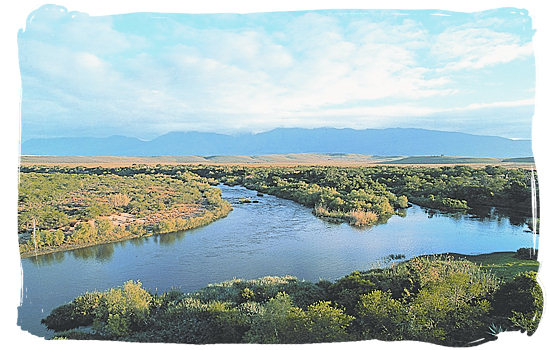
The Breede river, south western boundary of the Park
copyright © SANparks
Situated about 6km south of Bredasdorp near the N2 highway between George and Cape Town, the Park is the smallest and one of the oldest national parks in South Africa. You may not find anything spectacular on your visit to the Park, yet you will be touched by its own unique beauty. It is a lovely and beautiful nature reserve with a delightful tranquil atmosphere against the backdrop of the picturesque Langeberg mountain range on the one side and the Breede river on the other side.
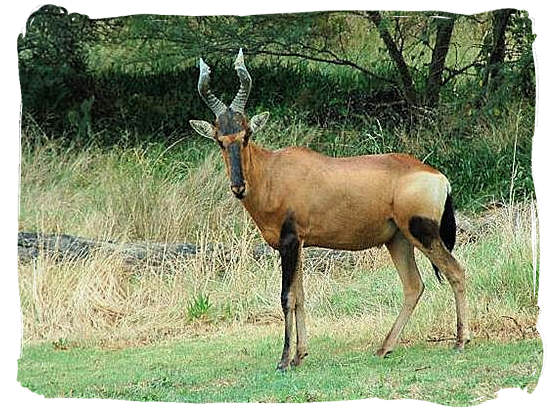
A Red Hartebeest antelope, also a rare antelope species to be found in the Bontebok National Park
Photograph by Kynan Cheng
The first inhabitants known to have lived in the Park area was the Hessequa clan of the Khoi people. They were a clan of herders, farming fat tailed sheep and long horn cattle. Every Khoi settlement was controlled by a captain and at times up to 17 captains would set up camp with their nomadic dwellings at the settlement of the most powerful Hessequa chief. The Park’s rest camp, "Lang Elsie's Kraal", is named after one of them, a female chief by the name of “Lang Elsie”, who lived with her clan at the southern part of the Park between 1734 and 1800.
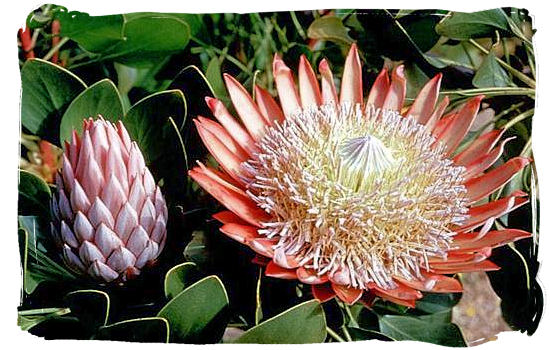
The King Protea, one of the most beautiful "fynbos" flowers of the Cape Floral Kingdom and also one of the national symbols of South Africa
copyright © South African tourism
The vegetation in the Park consists of "fynbos" and "coastal renoster veld", with many plant species that are found nowhere else in the world. Both are part of the Cape Floral Kingdom which is unique to South Africa and recognized as one of the most biologically diverse of the world's six floral kingdoms. There is something in bloom year round with the peak flower season in the spring. In total, the park has nearly 500 grasses and other plant species.
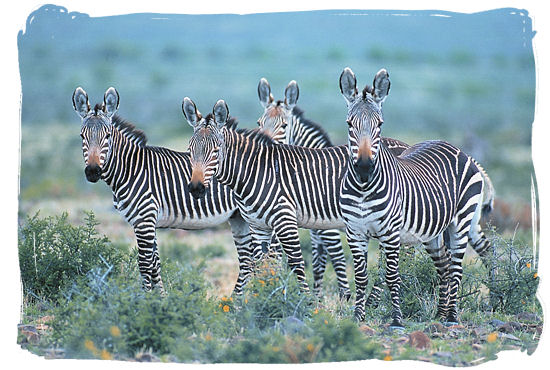
Small herd of the rare Cape Mountain Zebra, also to be found in the Bontebok National Park
copyright © SANparks
Large herds of Bonteboks used to roam the wide coastal plain of the south western Cape. Today the world’s bontebok population totals a mere 3000 animals, of which about 200 are to be found in the National Park. Here, they are joined by the Grey Rhebok, Cape Grysbok, Red Hartebeest, Jackal, Mongoose and other species of antelope as well as a rich diversity of birdlife. In addition there is a small number of the endangered Cape Mountain Zebra that visitors can see.
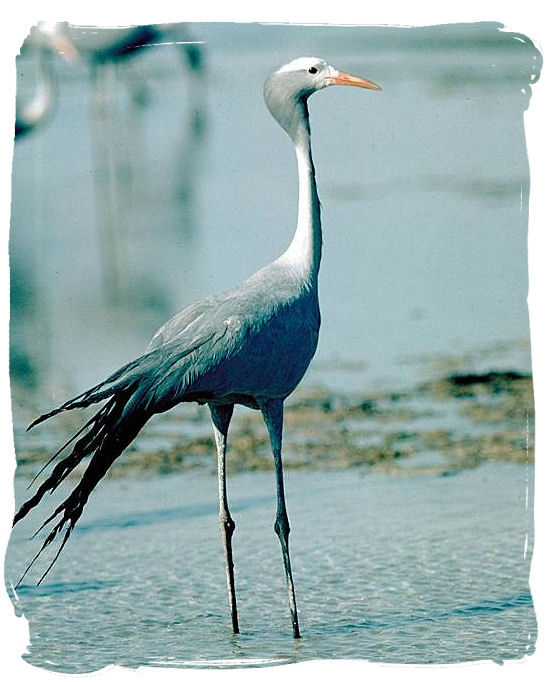
The beautiful Blue Crane, a national symbol of South Africa
The Park houses over 200 bird species and is noteworthy as an excellent place to see "Denham's (Stanley's) Bustard". Other large and visible species include "Blue Crane", "Spur-wing Goose", "Secretary-bird" and "Southern Black Korhaan". "Malachite" and "Southern (Lesser) Double Collared Sunbird" should be seen at the reception building. The campsite itself attracts quite a number of species, amongst them are the "Fiscal Flycatcher", "Klaas’s Cuckoo (summer)", "Acacia-Pied Barbet" and "Red-faced Mousebird".
<<< Top of Page
Facilities,...
The upgraded facilities include a renovated rest camp and a new road connecting the original park to 700 ha of new land donated in 2000 by the local municipality, which includes a key site named "Die Stroom" riverside, which is a day visitor facility, formerly a recreation site run by the municipality. The area also provides a location for a new entrance off the N2 highway, as well as a new tourist reception office
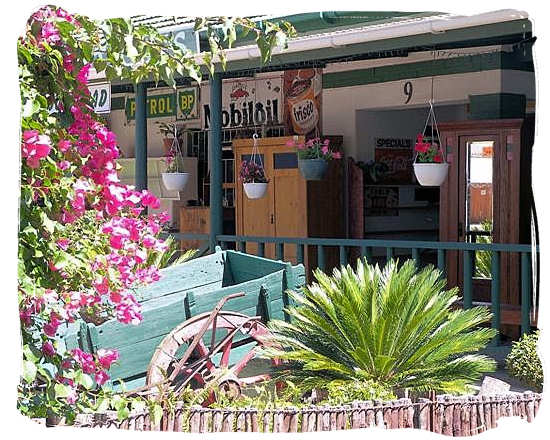
A little shop in Swellendam
The upgraded and renovated facilities at the Bontebok National Park include the following;
- Picnic and “braai” (barbecue) sites with ablution facilities are available for day and overnight visitors.
- A shop at the park entrance supplying basic commodities such as meat, beer, wine and curios.
- Fresh produce and other groceries have to be bought in the town of Swellendam, which is 6km away.
- The nearest petrol / fuel supply is also in Swellendam
<<< Top of Page
Activities,...
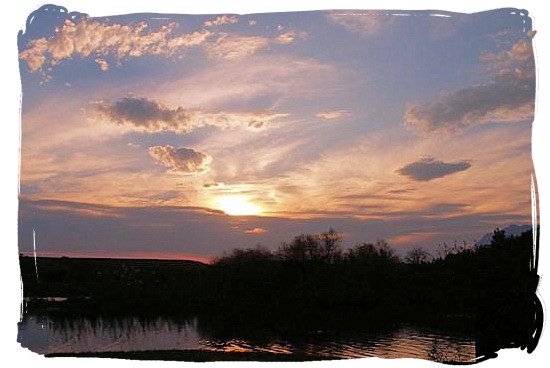
Sunset in the Bonteboks National Park
The Bontebok National Park is a great one day visitor location and a perfect stopover when you are en route between Cape Town and the "Garden Route". The Park can easily be accessed from the N2. Because of its fairly small size, visitors can drive around the whole park in a matter of hours and enjoy a picnic, swim, or a small hike to stretch the legs. It also offers passers by and local residents a great “braai” (barbecue) location or a place to take the kids to.
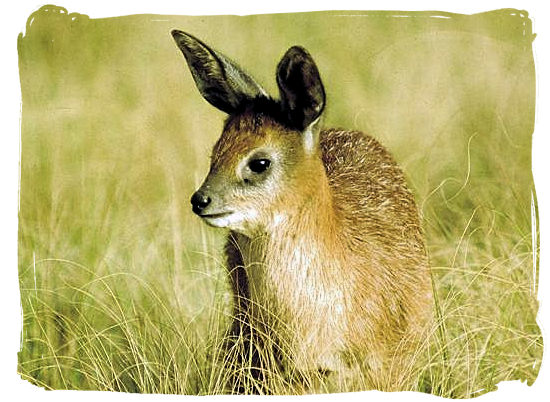
The small “Grysbok” antelope
copyright © South African tourism
The Park also serves as a useful base from where one can explore wine routes and historical buildings in and around nearby towns such as Swellendam, Robertson, Montagu, Ashton and Bonnievale. The hot springs for which Montagu has become famous for instance, will be a great experience. Another example is the Drostdy Museum at Swellendam with its rich historical content showing life at the Cape since the founding of the town in 1745.
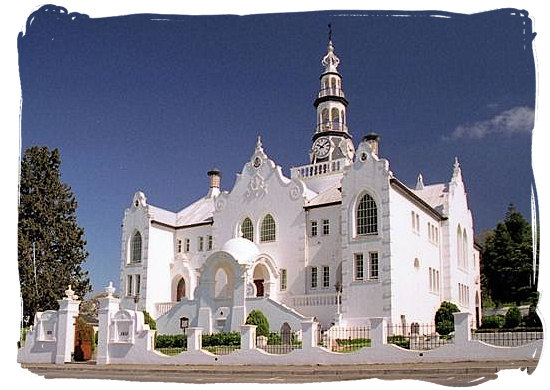
The historical Dutch reformed church building in Swellendam
Photograph by Brian Snelson
Other exciting activities that can be enjoyed in the Bontebok Park are;
- Firstly of course the beautifully colourful Bonteboks that can be seen roaming the park in their droves.
- Unusual antelope sightings, including the above-mentioned Bontebok, Grey Rheebok, Red Hartebeest and Cape Grysbok.
- For Birders to spot the Stanley’s Bustard and over 200 other species of birds that inhabit the park.
- The Breede river, providing the ideal setting for bird watching, fishing and swimming, between exploratory outings into the park.
- Enjoying a 6-day hiking trail that winds through the Langeberg Mountains and starts in Swellendam.
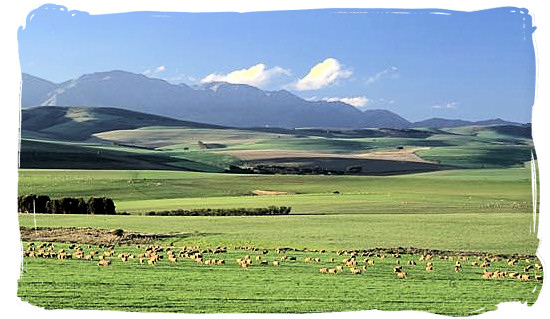
Landscape with grazing sheep near Swellendam
copyright © South African tourism
- Two short nature-hiking trails, starting and ending in the rest camp area.
- Bathing in the Breede River in the Rest Camp Area and soon at Die Stroom.
- Angling in the Breede River, anglers must be in possession of a valid angling permit, available for purchase at Park Reception.
- Canoeing/Kayaking in the Breede River, with own equipment.
- The Biking opportunities that are available, regular and mountain biking.
- Connecting to the people of the past and learn about how the Khoisan lived and changed through local history.
Climate,...
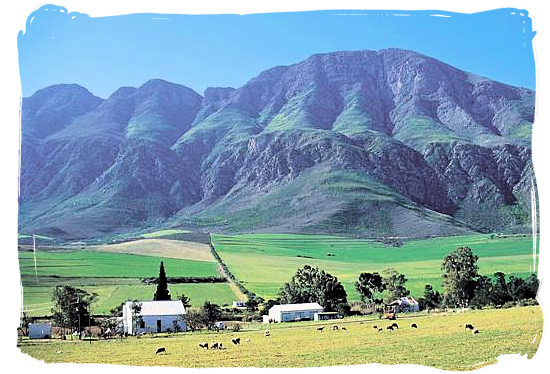
Farm at the foot of the Langeberg mountains not far from Swellendam
copyright © South African tourism
The climate in the Bontebok Park region is temperate with an average rainfall of ± 500mm per annum, occurring mainly during early summer and winter. Temperatures reach up to 40°C in summer and drop as low as 2°C in winter.
<<< Top of Page
Accommodation availability,...
Go to SANParks.org to view a monthly calendar with accommodation availability details of Bontebok National Park.
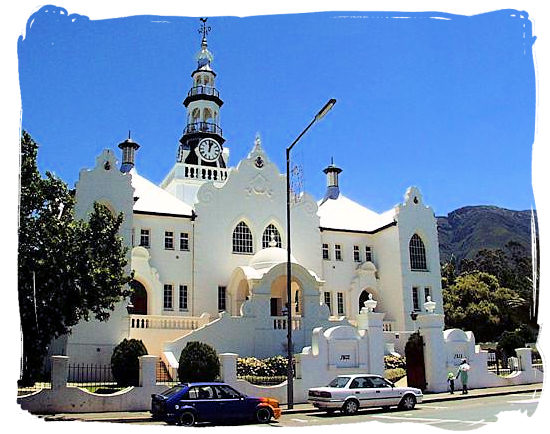
The Dutch reformed church, a historical building in Swellendam
Tariffs,...
Go to SANParks.org to view the tariffs applicable for the Bontebok National Park on the official tariff page of the South African National Parks (SANparks) website.
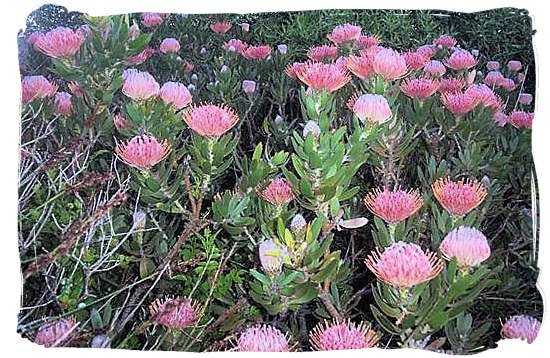
Flowering "fynbos", part of the unique Cape Floral Kingdom
Reservations,...
Go to SANParks.org to book your reservation for the Bontebok National Park on the official reservations page of the South African National Parks (SANparks) website.
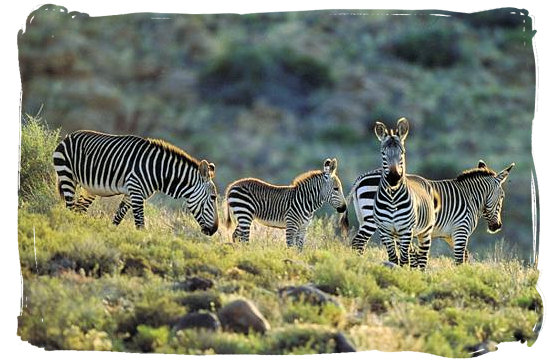
The rare Cape Mountain Zebra
copyright © South African tourism
<<< Top of Page
How to get there,...
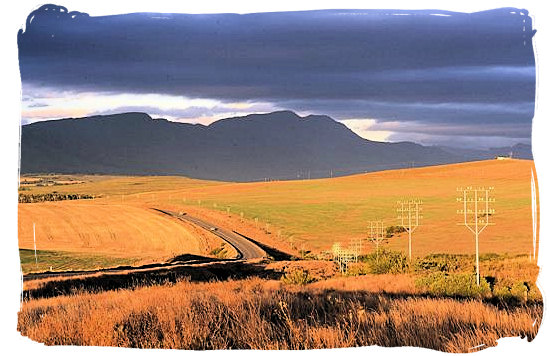
The N2 highway not far from the Bontebok National Park
copyright © South African tourism
The nearest airport is at Cape Town, approximately 240km away from The Park. The alternative is Port Elizabeth, which is 540km away. Flying to Cape Town and travelling by car from there, would probably be the quickest and most convenient way of getting to the Bontebok Park.
From Cape Town you follow the N2 to Swellendam, until you reach a (brown) sign saying Bontebok National Park just before Swellendam. Turn left onto the gravel road that will take you to the entrance of the Park, a distance of about 5km. At a speed limit of 120km/hr, you should be able to cover the whole distance in about 3 hours.
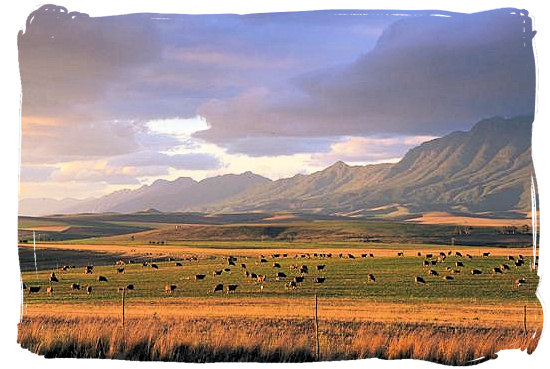
Sheep farming at the foot of the Langeberg mountain range
An alternative would be to charter a light aircraft at Cape Town and fly to the Swellengrebel airfield, which is adjacent to the Park, suitable for light aircraft only. Please note that all the internal roads in and around the Park are gravel.
<<< Top of Page
Video,...
The "fynbos" vegetation in the Bontebok National Park is part of the Cape Floral Kingdom, the smallest of the six floral kingdoms in the world, but biologically the most diverse. It is found in the Mediterranean climate region of the Western Cape province, which extends eastward into the Eastern province. The Cape Floral Kingdom contains 9600 species of vascular plants (plants with vessels for bearing sap), of which about 70 percent are endemic to South Africa, occurring nowhere else on earth.
The short video below will give you an idea what this type op vegetation looks like.
Top of Page
